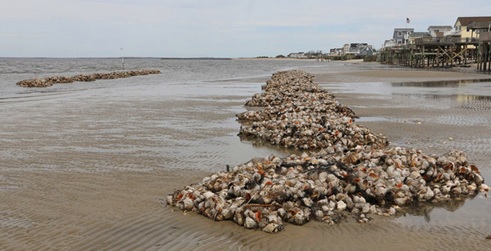 The red knot (Calidris canutus) is a robin-sized shorebird with one of the longest yearly migrations, traveling as many as 9,300 miles from its Arctic breeding grounds to the tip of South America. The Delaware Bay is important for red knots during their annual migration. While in the Delaware Bay, this bird depends on the energy-rich eggs laid by nesting horseshoe crabs (Limulus polyphemus).
The red knot (Calidris canutus) is a robin-sized shorebird with one of the longest yearly migrations, traveling as many as 9,300 miles from its Arctic breeding grounds to the tip of South America. The Delaware Bay is important for red knots during their annual migration. While in the Delaware Bay, this bird depends on the energy-rich eggs laid by nesting horseshoe crabs (Limulus polyphemus).

To gain enough weight to complete the last leg of the spring migration to their breeding grounds in the arctic tundra. Unfortunately, the red knot population has declined by more than 75 percent over the past thirty years, prompting the bird to be listed as threatened. One of the many threats responsible for the listing is climate change, which is expected to have an accelerated effect on the species as temperatures continue to rise, sea levels increase, and storms become more intense and erratic.
Climate change has the potential to warm the waters of the Delaware Bay and alter the timing at which horseshoe crabs lay eggs. If the waters warm too early and horseshoe crabs lay their eggs before peak red knot migration occurs, these birds may not reach the breeding grounds with enough fat reserves to successfully breed.
 |
|
|
2013 Beach restoration projects funded by U.S. Fish and Wildlife Service. |
Sea level rise may also reduce the amount of sandy beach habitat on the Delaware Bay; thereby reducing availability of feeding habitat for red knots during the most critical life stage. Rising waters will cover and displace the sandy beaches where horseshoe crabs lay their eggs. To address the threats from sea level rise, local communities are stabilizing and protecting shorelines with hard structures such as bulkheads and rip rap. This complicates matters because as horseshoe crabs lay their eggs above the high water line, crabs cannot reach nesting habitat along an armored shoreline.
Finally, climate change may pose a serious threat to the Delaware Bay through increased severity and erratic timing of storms. Hurricane Sandy was a major storm that destroyed many of the important sandy beach habitats on the Delaware Bay by washing away the sand and exposing sod bank or rubble, which are not suitable horseshoe crab spawning habitat.
The U.S. Fish and Wildlife Service and the National Fish and Wildlife Foundation have funded several beach restoration and living shoreline projects to benefit wildlife and the surrounding communities. Living shoreline projects are pioneering the placement of oyster reefs in front of restored beaches to help reduce beach erosion and to create calm water behind the reefs, which is favorable for spawning crabs. These same projects benefit the community by reducing the flood risk to beach and shoreline properties, as well as providing recreational opportunities. Local communities will also benefit economically as tourists come to the Delaware Bay to observe horseshoe crabs and red knots. “Working with local communities to address sea level rise is essential,” according to Wendy Walsh, the Service’s red knot coordinator. “Where communities turn to hard armoring, we know shorebird habitat will be lost. But living shorelines offer an alternative that seeks to meet the needs of both communities and shorebirds.” As these threats from climate change continue to accumulate, long term solutions to protect these important beaches will be necessary and we look forward to working collaboratively with local communities to protect the vital resources of the Delaware Bay.
by Katie Conrad
Katie Conrad, a Fish and Wildlife Biologist at the New Jersey Field Office, can be reached at katie_conrad@fws.gov
